 Relevancy and Engagement
dc.agclassroom.org
Relevancy and Engagement
dc.agclassroom.org
Hungry Pests
Grade Level
Purpose
This lesson teaches about invasive species: what they are, the threats they pose, and damages they can cause. Students will identify individual pests and invasive species and discover what they threaten, where they live, and the pathways hungry pests use to enter new locations. Finally students move into action and explore what they can do to prevent the spread of invasive species. Grades 6-8
Estimated Time
Materials Needed
Engage:
- 4 sheets of chart paper
- Markers
- A Lot of Mouths to Feed public service announcement
Activity 1: Attack of the Invasive Species!
- Attack of the Invasive Species factsheet, 1 per class or 1 per student group
- Attack of the Invasive Species! handout, 1 per student
Activity 2: A Day in Your Life With Invasive Species
- A Day in Your Life With Invasive Species, 1 copy per student
- Exploring the Threat cards, 1 copy per class with cards cut apart
- Exploring the Threat handout, 1 copy per student
Activity 3: Meet the Pests
- Pest Files Research handout, 1 per student
Activity 4: How Hungry Pests are Detected
- Hungry Pests Detectives Timeline handout, 1 per student
Activity 5: Invasive Species on the Move
- Vin Vasive’s “Top 8 Ways I Spread infographic, 1 copy per student
- Pest Pathway Storyboard handout, 1 copy per student
- Sticky notes and collage materials,
- Access to computers and Internet
Activity 6: How to Leave Hungry Pests Behind
Activity 7: Taking Action
- Blank sheet of paper, 1 per student
- Message Making handout, 1 per student
Vocabulary
agriculture: the science or practice of farming, including cultivation of the soil for the growing of crops and the rearing of animals to provide food, wool, and other products
Animal and Plant Health Inspection Service (APHIS): an agency of the United States Department of Agriculture (USDA) responsible for protecting animal health, animal welfare, and plant health
biological diversity: the amount of genetic, species, or ecosystem variation within an area
economic dependency: a country’s reliance on outside economies and countries for support
economic impact: the cost of invasive species on an area’s economy
grower: a person who grows a particular type of crop (fruits, vegetables, and grains)
native species: plants or animals that exist in an area naturally, not by human introduction
pest: an organism living and growing where it is not wanted and is causing damage to plants, humans, structures, and other creatures
treatments: actions taken to prevent damage caused by invasive species, including application of insecticides on trees, soil fumigation to reduce the number of root-infesting pests and diseases, solarization (covering a field with plastic and letting the sun “cook” the soil pests)
Did You Know?
- Invasive pests and diseases take a serious bite out of the U.S. fruit and vegetable industry each year. While the exact number may be hard to nail down, losses certainly reach into the billions of dollars.
- For just one disease (citrus greening) in one State (Florida), the losses are alarming: more than $4.5 billion was lost in citrus production from the 2006/07 to 2010/11 production seasons, according to University of Florida research.
- In Texas, the imported fire ant—a pest for a variety of crops, including fruits and vegetables—costs the State $1.2 billion annually, according to Texas A&M University AgriLife.
- Nationwide, a 2005 study calculated the annual cost of invasive species in all economic sectors to be close to $120 billion.
Background Agricultural Connections
Invasive species are a serious threat to our country and have the potential to devastate our crops and trees. This lesson will introduce to students the concept of invasive species. Students will begin to explore the damage and threat these pests cause and, most importantly, discover how invasive species can, or already do, impact their own lives and communities. Making the issue of invasive species relevant to students’ daily lives expands awareness and provides personal and group motivation for more research, learning, and action.
There are various types of farmers that invasive plants and animals affect:
- Dairy Farmers—raise cattle, goats, sheep, or other milk-producing animals
- Ranchers—raise livestock such as cattle, sheep, goats, and horses
- Poultry Farmers—raise chickens, turkeys, ducks, or geese for meat, egg, and feather production
Invasive species can cause potential human health issues such as:
- Meningitis—an acute inflammation of the protective membranes covering the brain and spinal cord that can be life threatening (the giant African snail can carry a parasite that can transmit this disease to people)
- Insect stings—painful wound caused by an insect’s stinger and venom
Invasive species can cause devastation effects such as:
- Push out native species.
- Place other species at increased risk of extinction.
- Reduce biological diversity.
- Kill forest trees.
- Alter wildfire intensity and frequency.
- Damage crops.
- Cost industry and government millions of dollars in treatment expenses.
- Prevent the sale of products from infested areas.
- Create economic dependency on products from other countries.
- Threaten the jobs of farmers, artisans, builders, and others who depend on agricultural and forestry products.
- Endanger personal health (e.g., stings from imported fire ants or meningitis from giant African snails).
Engage
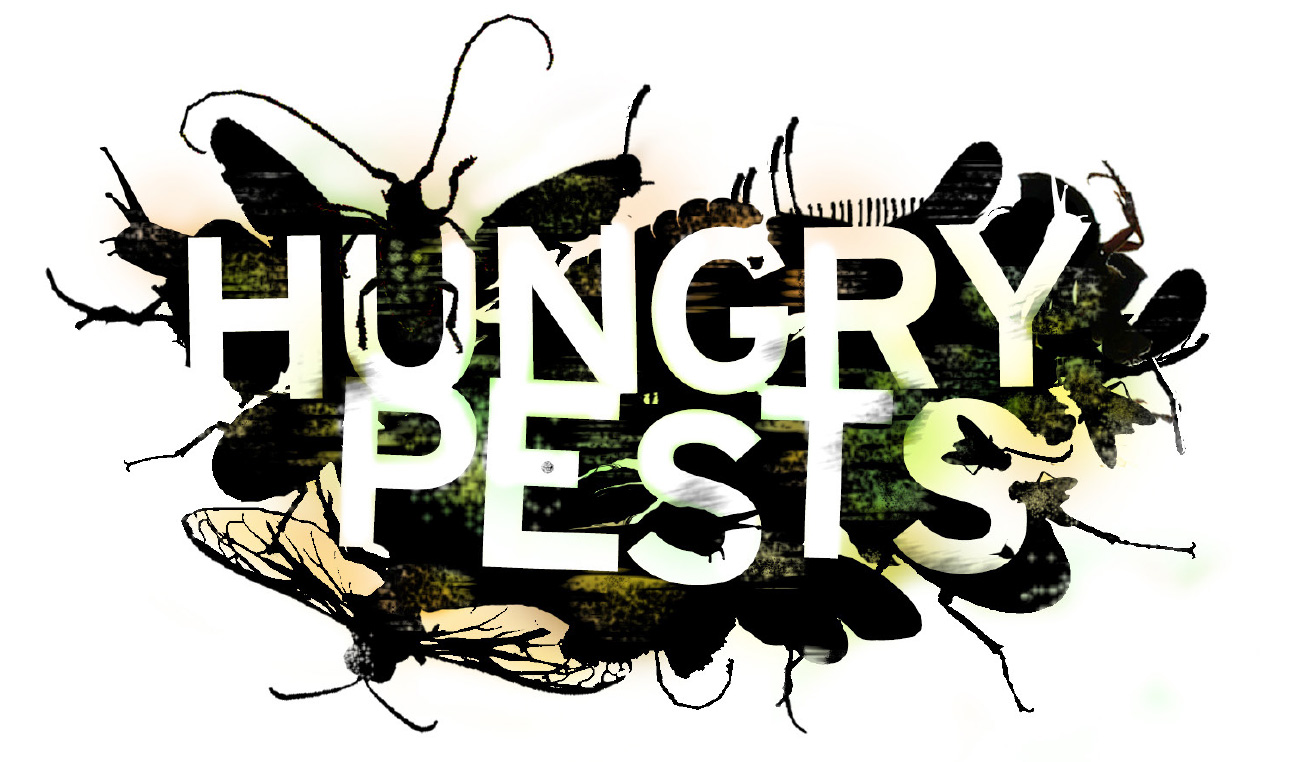 Introduce the concept of invasive species to students by having them draw upon existing knowledge about pests from real-world experience or previous units/lessons. Post the following questions on chart paper around the room:
Introduce the concept of invasive species to students by having them draw upon existing knowledge about pests from real-world experience or previous units/lessons. Post the following questions on chart paper around the room:
- What is a pest?
- What does invasive mean?
- What are species?
- What are invasive species?
- Ask students to move around the room and write a response for each prompt. After each student has visited each prompt, ask for a student representative to summarize the responses.
- Make sure students understand that invasive species can be plants, animals, or pathogens that are not native to an ecosystem and are likely to cause harm. In the following activities, students will focus on invasive plant pests and diseases. Alert students to the fact that invasive pests might even be found in their own backyards!
- Tip: MAKE IT VISUAL!- Make students squirm in their seats by sharing images of hungry pests. Refer to the Top Invasive Pest Threats page. Click on the pests of interest and use the right and left arrows on the image screen to scroll through the photos.
- Share with students an example of a hungry pest (invasive species) to help them further understand the elements of an invasive species. For example, the Giant African Snail is an invasive pest that was first found in southern Florida in the 1960s. It took 10 years and $1 million to eradicate it from the State, but the snail was reintroduced into Florida in 2011. The Giant African Snail is one of the most damaging snails in the world because it feeds on at least 500 types of plants and can cause structural damage to plaster and stucco structures. This snail can also carry a parasitic nematode that can lead to meningitis in people, making it a threat to human health. The giant African snail reproduces quickly, generating about 1,200 eggs in a single year.
- Optional: Print copies of the Giant African Snail Pest card to share with students.
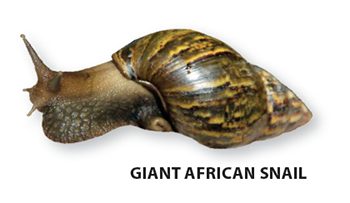
- Optional: Print copies of the Giant African Snail Pest card to share with students.
- Introduce students to Vin Vasive, the spokesbug for hungry pests everywhere. Play the 60-second PSA, A Lot of Mouths to Feed to expose students to Vin’s menacing ways. Afterward, have students share their reactions to Vin Vasive and make predictions about the kinds of damage he might bring to agriculture and the environment, as well as the problems he might cause for people.
Explore and Explain
Activity 1: Attack of the Invasive Species!
- Provide students with more information on invasive species, by having students read the Attack of the Invasive Species! factsheet. Students can read individually or in small groups.
- Tip: JIGSAW READING- Break up the Attack of the Invasive Species! factsheet by assigning small student groups to read each section. After groups have read their own sections, have them share what they learned with the rest of the class. Take it to the next level by having each group create a pest team name. (For example: “Pest Preventers,” “Bug Busters,” or “Team Invasive Species.”)
- Give each student one copy of the Attack of the Invasive Species! handout and instruct them to answer the questions. If needed, students can refer back to the factsheet (in step 1) to answer the questions.
- After students complete the worksheet, review each question and call on students to share their answers. Have them generate a list of any unanswered questions they still have about invasive species. Keep the list visible in the classroom for students to reference, and have them work to answer the questions as they learn more about invasive pests in future activities.
- Tip: DRAW IT!- After students have finished the "Attack of the Invasive Species!" worksheet, have them flip the page over and create a pictorial representation of the article.
- Summarize your class discussion by informing students that an Executive Order was signed on February 3, 1999 by former President Clinton to create the National Invasive Species Council (NISC) and establish other measures to monitor and control the invasive species.
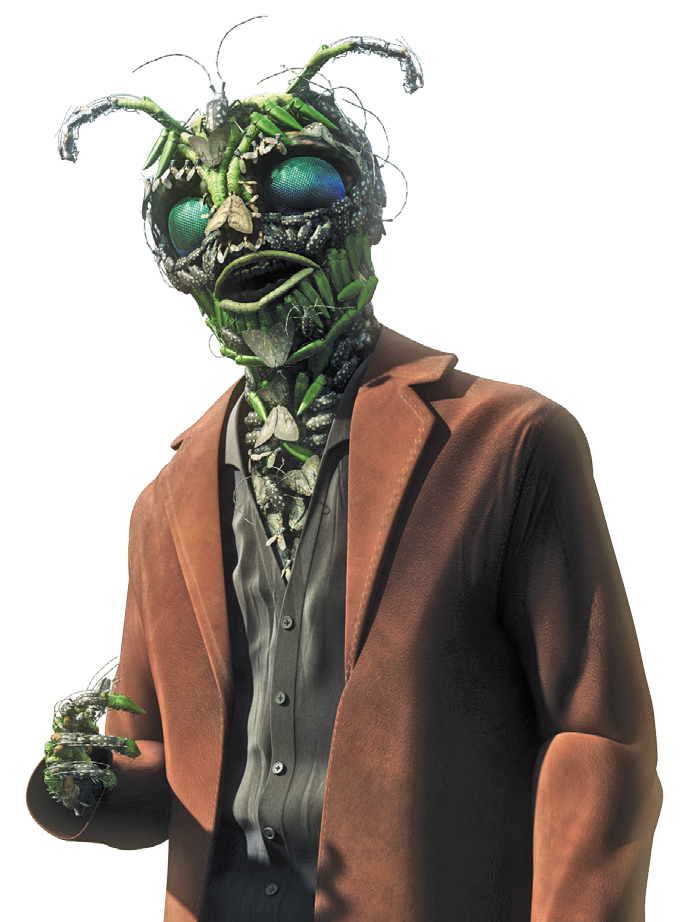
Activity 2: A Day in Your Life With Invasive Species
- Have students read the USDA blog post, A Day in Your Life With Invasive Species. The article explains how invasive species can impact our daily lives, from the breakfast table to an afternoon baseball game.
- Tip: A DAY IN YOUR LIFE REFLECTIONS- Have students draft short paragraphs sharing one thing they learned that surprised them from the A Day in Your Life With Invasive Species blog post. Students can use the following prompt: “After reading the A Day in Your Life With Invasive Species blog post, I was surprised to learn that…”
- Now that students have gained more awareness of invasive species and discovered the impact these pests could have in their own lives, have them dig deeper to discover the various environmental, economic, and human health damages invasive pests can cause.
- Have students draw an Exploring the Threat card from a hat or box. (Note: There are 11 threat cards. Depending on class size, students can share cards and work in pairs or groups of three).
- Each card contains a different threat and additional prompts (e.g., Why is biodiversity important? What trees grow in my community?) to help students reflect on the impact each threat could have in their community and their state.
- Have students research the card they selected using the Exploring the Threat research sheet.
- What is the threat?
- What kind of threat is it? (Environmental, Economic, Human Health)
- How is this threat connected to the environment, the economy, or human health?
- How does this threat cause concerns for the environment, economy, or human health?
- What are some of the unintended consequences of the problem?
- Tip: GUEST SPEAKERS- Invite local farmers, growers, artisans (who depend upon natural materials), or builders to the class as guest speakers. Have them explain their job to students and reflect on the potential damage invasive species could cause to the work they do.
- After students have researched their individual card, they can move into larger groups based on the overall categories (environment, economy, and human health) and create a group presentation to share what they’ve learned with the rest of the class.
- Tip: MIX IT UP!- Invite students to get creative when presenting their research. For example, they could create a commercial, song, skit, or poster.
- Have students reflect upon the impact invasive species can have on them personally by writing a journal entry in response to the prompt: “I care about invasive species because….” Require students to include text references from the A Day in Your Life With Invasive Species blog post and the research they did in the Exploring the Threat activity.

Activity 3: Meet the Pests
- Have students build on their invasive species knowledge by getting to know individual pests better. Ask them to take on the role of “invasive species investigators” and select three invasive pest threats they are interested in learning more about. These can be pests that are in your state or neighboring states or pests from the targeted 15 invasive pests.
- Note: Depending on class size, students could work in teams. Make sure that the class covers as many different species as possible to complete a full classroom set. If there is more interest in certain pests than others, have students randomly draw their three pests from a hat.
- The following Hungry Pests are most likely to be moved accidentally by the general public:
- Tip: HUNGRY PESTS IN YOUR STATE- Visit the Pest Tracker to see which pests are specifically threatening your community, State, and neighboring States.
- Give each student one copy of the Pest Files Research worksheet to collect all of the clues and document their research. As they complete the worksheet, ask students to leave the last section (“What you can do to stop the spread”) blank for now. Students will revisit that question later.
- Tip: CAREER CONNECTIONS- As students are working on their pest files, take the time to connect their research to future career pathways.
- Scientific Illustration: Students who become interested in drawing and sketching the pests will be excited to learn that being an insect or botanical illustrator is a viable career option. These illustrators create detailed drawings for scientific research and textbooks.
- Computer Mapping and GIS: Students who enjoy mapping the pest locations will be interested in the wide range of career opportunities involved in creating maps and analyzing their results. GIS (geographic information system) is sophisticated software used to capture, manipulate, manage, and present many different kinds of geographic data, including pest locations.
- Tip: CAREER CONNECTIONS- As students are working on their pest files, take the time to connect their research to future career pathways.
Activity 4: How Hungry Pests are Detected
- To better understand how invasive species are detected, reported, confirmed, and recorded, have students create a timeline of the process using the Hungry Pests Detectives Timeline worksheet. Give each student one worksheet and ask them to document each step of the process and visually explain what happens in each step with a drawing. Encourage students to think about how to communicate this information creatively.
- Write the following list of “How Hungry Pests Are Detected” on the board, and have students discuss each step.
- How Hungry Pests Are Detected
- Often, a regular person (like you or me) is the first to notice an invasive pest (in the garden or at a park, on a walk, while camping, or during similar activities.) Federal or State pest survey specialists or farmers also find signs of plant pests and diseases.
- Sightings are then reported to the local land manager or local USDA office (www.aphis.usda.gov/planthealth/sphd).
- If it is a first detection in the entire country, the reporting has to go through an important “Chain of Custody.” Chain of custody means that the movement of the sample is tracked and documented as it goes through the identification process and that only authorized agricultural officials can make the final confirmation.
- USDA scientists identify the pest, confirming the detection. A DNA analysis may be performed.
- If needed, information such as photos from a microscope or the sample itself may be sent to the Smithsonian Institution to confirm the identity.
- Information is then sent to various databases, organizations, and individuals to help notify other interested people or groups of the detection.
- In conjunction with State partners, USDA announces the detection to the world.
- How Hungry Pests Are Detected
- Explain to students that once an invasive species is detected and confirmed, one way the information is communicated to the public is through mapping.
- Have students look specifically at your state and community and discuss the findings. Ask them to observe and hypothesize: What invasive or non-native pests are found in your State? Why do you think that is? Remind students that reported or mapped detections don’t necessarily indicate spread. If pests or diseases are detected in a location, USDA will begin looking in other areas where they could become established and, as a result, more pests may be detected. However, it can be difficult to determine whether pests or diseases found at one location came from an existing infestation or another source. Separate introductions from different sources might have occurred.

Activity 5: Invasive Species on the Move
- Introduce students to the top ways that hungry pests enter new locations and spread (also known as pathways). Give each student one copy of the infographic Vin Vasive’s “Top 8 Ways I Spread. Pathways are any means that allow the entry or spread of a pest or disease. Pathways could be plants, plant parts, agricultural products, wood packaging, soil, containers of all kinds, or vehicles that are contaminated with pests, disease-causing microbes, or seeds from harmful weeds. People can accidentally move these dangerous, invasive hitchhikers across countries, continents, and oceans.
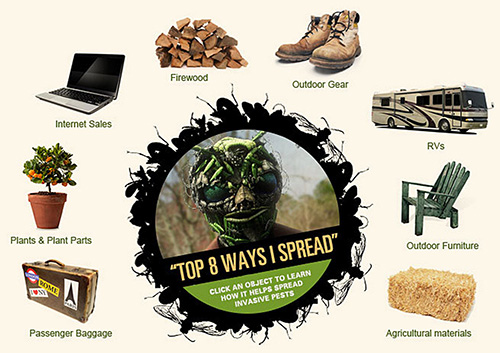
- Have different students volunteer to read each pathway aloud to the class. Pause after each and ask students to raise their hands if they have had any personal experience with the pathway. (For example: Does your family own an RV? Have you ever gone camping and used firewood?)
- Using Vin Vasive’s “Top 8 Ways I Spread” Infographic, have students select one pathway to explore further. (Note: Make sure that every pathway is accounted for among students.)
- Give each student 1 copy of the Pest Pathway Storyboard handout and assign them to create a storyboard that tells the story of their pathway. For example, how might a pest use firewood to enter a new location and spread? Outdoor furniture? Plant parts? Have students research their pathway online and collect any information that will be helpful when creating the storyboard.
- After students have finished their research, have them transfer the information they gathered into a three-part storyboard. Students can draw each image or create collages using magazine clippings and cut paper. Share the following as an example:

- Before: What was the situation like before the invasive species was introduced?
- Example: Citrus is plentiful and local farmers are profiting from its sale.
- Pest Introduction (Cause): How is the hungry pest introduced? Where does it come from? (Pathway)
- Example: An international traveler accidentally brings a Mediterranean fruit fly (or Medfly) maggots hiding on undeclared fresh fruit into the United States.
- After (Effect): What happens to the situation now that the invasive species has been introduced?
- Example: The Medfly maggots begin to feed inside fruits and vegetables like citrus and peppers, causing them to spoil and rot! Local farmers are unable to sell the damaged citrus as they usually would, and their jobs become threatened.
- Tip: STORYBOARD BASICS AND INSPIRATION- Explain to students that storyboards are graphic organizers that use a sequence of images and captions to explain a story in chronological order. They are often made to guide the creation of a commercial, movie, or animation. They are also used in comic books or graphic novels. To help inspire students with their storyboards, find examples of movie, comic, or graphic novel storyboards online to share with students. Then, have students discuss the pros and cons of using only illustrations to tell a story.
- Example: The Medfly maggots begin to feed inside fruits and vegetables like citrus and peppers, causing them to spoil and rot! Local farmers are unable to sell the damaged citrus as they usually would, and their jobs become threatened.
- Before: What was the situation like before the invasive species was introduced?
- Once students have completed their storyboards, have them group the storyboards by pathway and display them on a classroom wall.
- Give each student a small stack of sticky notes to list different ideas on each storyboard about how the pest might have been stopped. For example, people can help stop the spread of pests via outdoor gear by making sure to clean their shoes before leaving a camping trip.
Activity 6: How to Leave Hungry Pests Behind
- USDA has identified seven key things people can do to help prevent the spread of invasive pests. To introduce students to each of the seven tips, show them the video Seven Ways to Leave Hungry Pests Behind.
- Seven Ways To Leave Hungry Pests Behind:
- Buy Local, Burn Local. When you are camping outside and need to start a fire, buy local firewood. Invasive pests and their larvae can hide and ride long distances in firewood. Don’t give them a free ride to start a new infestation. If you must move firewood (even just a short distance), make sure it has been heat-treated to kill any pests that might have been in or on it.
- Plant Carefully. Ask your parents to avoid using plant species in their gardens that could bring invasive pests to your State. For example, orange jasmine, a common landscape plant in citrus-producing States can carry the Asian citrus psyllid! Make sure plants are purchased from reputable nurseries.
- Don’t Bring or Mail fresh fruits, vegetables or plants into your State or another State unless agricultural inspectors have cleared them beforehand.
- Cooperate With Quarantines. Cooperate with any agricultural quarantine restrictions and allow authorized agricultural workers access to your property for pest or disease surveys.
- Keep It Clean. Wash outdoor gear, shoes, and bikes between fishing, hunting, or camping trips. Clean lawn furniture and other outdoor items (such as swing sets, soccer balls, toys, kiddie pools, and portable sandboxes) when moving from one home to another.
- Learn To Identify. If you see signs of an invasive pest or disease, write down or take a picture of what you see and then report it to your nearest USDA office. Visit www.aphis. usda.gov/planthealth/sphd for contact information.
- Speak Up. When returning from international travel, tell U.S. Customs and Border Protection officers at the port of entry (airport, seaport, or land border) if you are carrying any agricultural items or food. To learn more, go to www.aphis.usda.gov/travel. You can also call USDA-APHIS at (301) 851-2046 for plant-related questions or (301) 851-3300 for animal-related questions.
- Seven Ways To Leave Hungry Pests Behind:
- After students have watched the video, split them up into seven different teams, one for each way to leave hungry pests behind. Have students work within their teams to create a large poster for their pathway. Make sure that students have a catchy “call to action” for each poster—a short description to help explain what someone can do to prevent invasive pests from spreading—and an interesting visual. Remind students to think about what will attract a viewer to stop and read the information on their poster.
- Poster Checklist:
- Call to action. Example: Don’t mail me!
- Short description to explain the pathway. Example: Invasive species like the Asian citrus psyllid can hitchhike on plants, and Mediterranean fruit fly larvae can hide inside fresh fruits and vegetables. Don’t mail fruits or vegetables to friends or family unless agricultural inspectors have cleared them for you. For guidance, call your local USDA State Plant Health Director’s office.
- Interesting visual. Example: A drawing of a package filled with fruits and vegetables with an Asian Citrus Psyllid on top.
- Other Call-to-Action Examples:
- Going camping? Don’t move firewood!
- Clean your boots and bikes!
- Think before you pack!
- When you come home from vacation, declare your fruit or beware!
- Helping with a new school garden? Plant carefully!
- While the posters are in progress, hang them up for a quick class critique. Have each group present their poster and ask students to provide constructive feedback and suggestions for improvement. Have fellow students think about the following questions for each poster design:
- What is the call to action?
- Is the pathway clear?
- Does the poster’s visual make me want to stop and look? Is it memorable? Make sure groups take notes during the critique and integrate any important changes into their poster design.
- Tip: GLOW AND GROW-Guide the classroom critique of student work by asking for peers to share one glow (something the poster is doing really well) and one grow (something the poster could improve upon) for each poster.
- After the posters are complete, laminate and hang them up around the school to share the information with other students, teachers, and staff. Posters can also be photographed and displayed on a class blog or school Website.
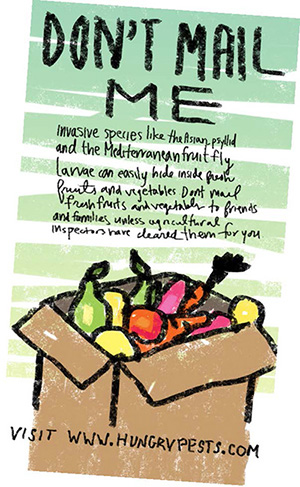
Activity 7: Taking Action
- Many people interact with invasive species without realizing it. Based on their outdoor activities, outdoor hobbies, or occupation, “movers and shakers” are people who can play a valuable role in helping to stop the spread of pests. Have students break into teams of two or three and randomly select a category from the list of people who may interact with invasive species.
- International travelers
- Outdoor enthusiasts
- Hunters
- Gardeners
- Bird watchers
- Loggers and foresters
- Commercial producers
- Summer campers
- Growers, ranchers, and farmers
- Sports players
- Urban park rangers
- To help bring the profile characters closer to home, have each student create a web on a blank piece of paper that maps all of the people they know (including themselves!) who fall into the above categories.
- After students have created their webs, ask them to pause and consider how they could help each target audience understand the importance of stopping the introduction and spread of invasive species.
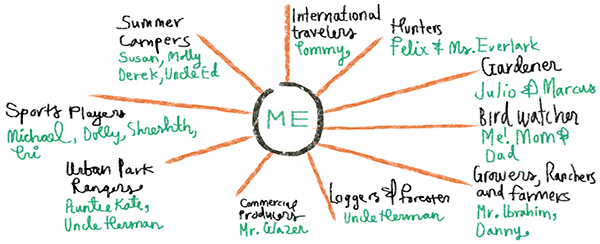
- Have students pick one person in their web and create a personalized list of actions each person can take to help stop hungry pests. For example, a student who knows a gardener might remind him or her of the following actions:
- Learn more about invasive plants and avoid planting those that could bring invasive pests into your state.
- Inspect plants for signs of disease or pests before planting them. Report any signs to your local Extension office or Master Gardener program.
- When purchasing plants online or through a catalog, check first with a local USDA office to see if any restrictions apply.
- Now it’s time for students to apply what they learned by evaluating and creating an invasive species public outreach campaign.
- To prepare students for creating their own invasive species outreach campaign, have students discuss and evaluate what a public service announcement is.
- Give each student one copy of the Message Making handout. Then watch the Hungry Pests PSA videos.
- Tip: REPLAY!- Shorter PSAs can pack a lot of information into a small period of time. Replay each PSA two to three times to make sure students catch everything. You can even pause before each showing and ask students to focus on a particular aspect, such as the messaging, visuals, or call to action.
- After viewing each PSA, ask students to critically evaluate each campaign (using the Message Making handout). Make sure students consider target audience, messaging, content, and call to action when assigning their grade.
- Tip: INSPIRING ACTION- Push students to think critically about the PSAs they are evaluating. Have students identify one PSA to journal about in more depth. Make sure they answer the following questions in their reflection writing: Why is the PSA effective? How does it inspire me to act? Repeat the Message Making worksheet and grading process for as many PSAs as possible.
- Have students create their own PSAs educating the public about invasive species
Elaborate
- Vin’s Vocabulary: Collect new and unknown invasive species vocabulary to add to a classroom list. Vocabulary may include: agriculture, certified, compliance, entomology, eradicate, infestation, invasive, native/non-native, quarantine, regulations, safeguard, smuggle, species, and USDA. Once the word is added to the list of “Vin’s Vocabulary,” give students points for each time they use one of the words in a class discussion or in writing. At the end of the unit, name the student with the most points the Ultimate Vin’s Vocabulary Champ!
- Protect Your Environment Trek: Go on a nature walk and observe the native species that can be or are impacted by invasive species. Students can prepare for the trip by visiting the pest profiles on www.HungryPests.com to research host plants and creating a checklist of those native to their area. As students identify items on their checklist, ask them to pause and consider why these plants are important and what would happen if invasive species threatened them. After the trip, students can write in their journals about how the trip might have affected their view of the local environment.
- Natural Resources Research: Wood Is Wood, Isn’t It? To explore how invasive species can impact a widely used natural resource (wood), have students research and explore different tree species, where they grow, and how various woods are used in their community, in our country, and in products they use on a daily basis.
- Hungry Pests on the Prowl: Define the five types of relationships in the animal and plant kingdoms (i.e., mutualism, predation, parasitism, competition, commensalism). Then, identify which one describes the relationship between hungry pests and the plants they like to eat (parasitism).
- No Pests Taste Test: Plan a class Hungry Pests Potluck featuring food that could be threatened by invasive species, and invite the school’s administration and staff to join in. Food could include: oranges, orange juice, grapefruit, limes, lemons, grapes, corn, eggplant, lima beans, bananas, avocados, apricots, peaches, tomatoes, walnuts, rice, noodles, and other items impacted by hungry pests. Students can create a menu or make cards to place next to each food noting the invasive species that attack it.
- #HungryPests: Invite students to stay current on hungry-pest news and the adventures of Vin Vasive by liking “Hungry Pests” on Facebook or Twitter (@HungryPests) and sharing updates with their friends. Depending on your classroom technology policy, have students use their smart phones as “palmtops” (laptops in the palms of their hands) at key moments during the lesson to tweet and post what they are learning about invasive species.
-
Threat Cards: Have students answer the prompt on their threat card (from Activity 2) in their journals. After students are finished, they can share their response with a peer or invite students to read them aloud to the class. Use the prompts on each threat card for longer and more in depth personal research projects. Explore the connections between threat cards by creating “story webs.” Students should explain their thinking with each connection. For example:
- Dead forest trees could lead to more wildfires.
- Damaged crops could threaten the jobs of farmers and artisans.
- Forest pests could harm builders who may need to pay more for certain lumber.
Turn it into a game by rewarding the student who can identify the most connections. Laminate the cards to prolong their use.
- What’s Up With Wildfires? Investigate wildfires—another way, aside from invasive species, that natural resources are threatened. Students can research and discuss local stories or events caused by wildfires and visit the Smokey Bear Website to learn more.
Evaluate
After conducting these activities, review and summarize the following key concepts:
- Invasive species can severely damage agricultural crops.
- Most states have the potential for an infestation of invasive species. Habitat and climate determine the level of risk if the pest could thrive.
- Invasive species impact our food supply by damaging crops.
- Invasive species spread in many ways including firewood, outdoor gear, internet sales, plants and plant parts, passenger baggage, agricultural materials, outdoor furniture, and RV's.
- Eradication efforts are taking place for invasive species across the country. Some have already proven successful.
- International traveling and camping are two activities where people should pay particular attention to prevent the spread of invasive species.
Acknowledgements
Hungry Pests Invade Middle School curriculum from the USDA Animal and Plant Health Inspection Service with the following advisors:
Pest Management Group:
- Pest Management Division of USDA’s Animal and Plant Health Inspection Service (APHIS)
- Stephanie Bloem, Entomologist, Risk Analyst, Training Specialist, APHIS
- Heather Curlett, Outreach and Risk Communications Coordinator, APHIS
Teacher Advisory Board:
- Colleen Guertin Parenteau, Science Educator and Sustainability Chair, Shore Country Day School, Massachusetts
- Doug Streblow, Environmental Educator, EarthTeam, California
- Martina McGee, Classroom Teacher, Houston Independent School District, Texas